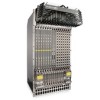Dell Force10 E1200i Installing and Maintaining the E1200i System - Page 77
AC Power Supplies and Alarms, SFMs and Alarms, show alarms
 |
View all Dell Force10 E1200i manuals
Add to My Manuals
Save this manual to your list of manuals |
Page 77 highlights
AC Power Supplies and Alarms During system boot, if the redundant power supply (the fourth power supply) is missing or fails, the FTOS does not generate any alarm messages since the minimum configuration of three power supplies is operating. Yet, if a fourth AC power supply is installed, and later one of the four power supplies is removed or fails, the system generates a minor alarm. If only three power supplies are installed and one of them fails while the E1200 is operating, the software generates a major alarm and an SNMP trap, lights the major LED, and activates the audible alarm. When you operate the E1200 with three AC power supplies and six or more line cards, the software lists a redundancy alarm on the console and in the show alarms command output. All line cards operate normally. SFMs and Alarms The number of SFMs present in the system when it boots determines the level of alarms sent when a tenth (redundant) SFM is removed or fails. At boot time, if ten SFMs are present and functioning, the E1200 system issues no alarms. However, if one SFM fails or is removed, the system sends a minor alarm stating that nine SFMs are present. The system requires eight functioning SFMs to pass traffic. At boot time, if eight SFMs are present and functioning, the E1200 system issues no alarms. The system issues no alarms if an SFM is added to the system; however, if the number of functioning SFMs changes from nine to eight, the system sends a minor alarm event. The system always triggers a major alarm when the number of working SFMs reaches seven. Alarms | 77















